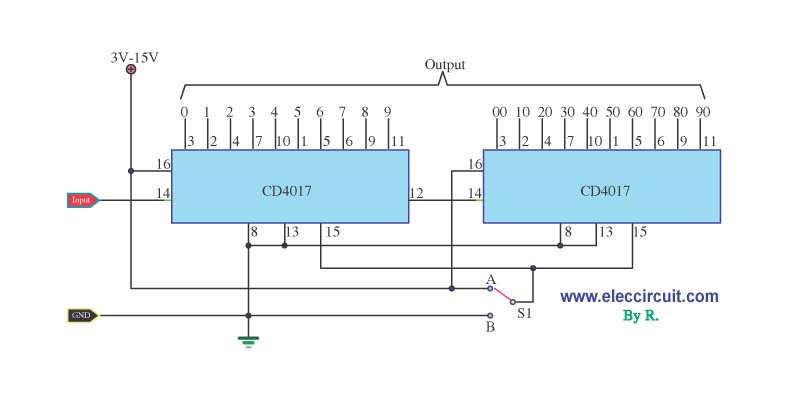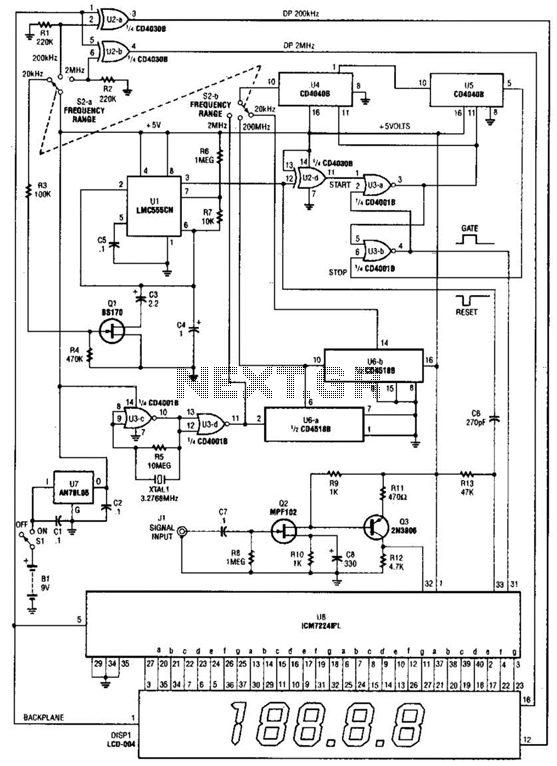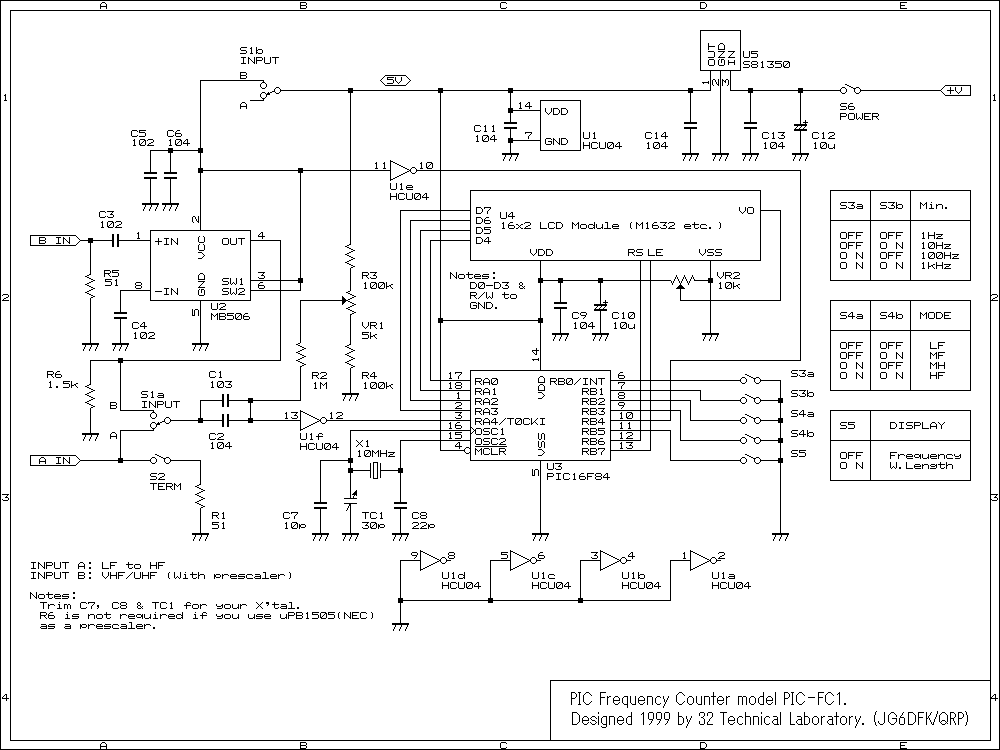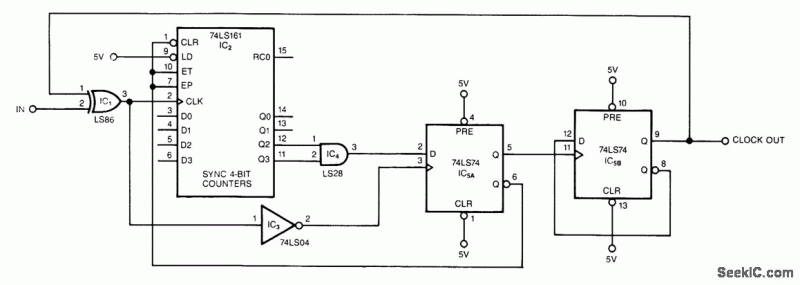
The counter

The circuit of this device is relatively straightforward. An input circuit filters the signal from the antenna to minimize sensitivity to other phenomena and protect against overvoltages. Four transistors create a "one-shot" section that is activated by the input circuit, generating pulses of approximately 0.05 seconds for the counter, determined by a 470nF capacitor. Once triggered, the one-shot cannot be retriggered for about one second due to an 8F polarized capacitor, preventing multiple counts for the same event. The circuit is powered by a 6LR61 9V battery, and since the power consumption is less than 1A when no events are detected, a single battery can last for several years. A test button allows verification of battery functionality; pressing it increments the counter, and holding it down results in an increment approximately once per second. Two optocouplers interface the output of the one-shot circuit with the actual counter and a PC. A digital 5-digit LCD counter, powered by a single LR6 (AA) 1.5V battery, is used. The counter consumes about 1.5A, with a battery life of about one year. It also includes a reset switch and a piezo speaker that beeps with each operation. Any other counter, including mechanical ones, can be utilized, but the interface will need modification. The insulation provided by the optocoupler between the counter and the one-shot is not strictly necessary; an optocoupler was used to adapt the two different supply voltages (9V and 1.5V). A transistor and a resistor could suffice. A 6-9V DC counter can be directly connected between the collector of the 2N2904 and ground. This circuit is not critical, and any similar semiconductor can be substituted. The input circuit employs power resistors and high-voltage capacitors, necessitating proper insulation. For enhanced accuracy, the input circuit should utilize 1% precision components.
The device's circuit design incorporates several key components and features that enhance its functionality and reliability. The input circuit is crucial as it not only filters incoming signals but also serves as a protective barrier against voltage spikes, ensuring the integrity of the subsequent circuitry. The choice of four transistors in the one-shot section allows for effective pulse generation, providing precise timing control for the counter. The 470nF capacitor is critical in determining the pulse duration, while the 8F polarized capacitor ensures that the one-shot mechanism is adequately timed to avoid erroneous multiple counts.
Power management is an essential aspect of this design. The use of a 6LR61 9V battery is advantageous due to its longevity, especially given the low power consumption of the circuit under normal conditions. The test button feature is a practical addition, allowing users to verify the operational status of the unit easily. The incrementing counter response provides immediate feedback, which is particularly useful for maintenance checks.
The integration of optocouplers facilitates the safe interfacing of different voltage levels between the one-shot circuit and the counter, preventing potential damage from voltage mismatches. This design choice enhances versatility, allowing the use of various counter types, including digital and mechanical, provided the necessary interface adjustments are made.
The digital 5-digit LCD counter is a suitable choice for this application, balancing power consumption with functionality. The inclusion of a reset switch and piezo speaker enhances user interaction, providing audible confirmation of operations.
In terms of component selection, the recommendation for 1% precision parts in the input circuit underscores the importance of accuracy in signal processing. The use of high-voltage capacitors and power resistors necessitates careful insulation to ensure safety and reliability. Overall, this circuit design exemplifies a well-thought-out approach to creating a robust and efficient counting mechanism, suitable for various applications.The circuit of this device is quite simple: an input circuit filters the signal provided by the antenna to reduce sensibility to other phenomena and protects against over voltages. The four transistors realize a "one-shot" section that is triggered by the input circuit and provides pulses of about 0.
05 seconds to the counter (the 470nF capacitor s ets this time). When the one-shot is triggered it cannot be retriggered for about one second (imposed by the 8 F polarized capacitor) to avoid multiple counts for the same strike. This part is powered by a 6LR61 9V cell and, since the power consumption is lower than 1 A (when no strikes are detected) a single cell will last for some years.
The test button allows to check if the battery is still operational: each time it`s pressed the counter should increment and, if hold down, the counter should increment about once per second. The two optocouplers interface the output of the one-shot circuit with the real counter and with the PC.
I used a digital 5-digits LCD counter powered by a single LR6 (AA) 1. 5V cell. The power consumption of this counter is about 1. 5 A and the battery life is about one year. This counter also has a reset switch and a piezo speaker that beeps on every operation. Any other counter should work fine (even mechanical ones) but the interface must be modified. The insulation between the counter and the one-shot provided by the optocoupler here is not necessary: I just used an optocoupler to adapt the two different supply voltages (9V and 1. 5V). A transistor and a resistor could work as well. A 6-9V DC counter can be directly connected between the collector of the 2N2904 ant the ground. This circuit is not critical and every semiconductor can be replaced with similar ones. The input circuit uses power resistors and high voltage capacitors: it must be well insulated. For better accuracy the input circuit should use 1% precision parts. 🔗 External reference
The device's circuit design incorporates several key components and features that enhance its functionality and reliability. The input circuit is crucial as it not only filters incoming signals but also serves as a protective barrier against voltage spikes, ensuring the integrity of the subsequent circuitry. The choice of four transistors in the one-shot section allows for effective pulse generation, providing precise timing control for the counter. The 470nF capacitor is critical in determining the pulse duration, while the 8F polarized capacitor ensures that the one-shot mechanism is adequately timed to avoid erroneous multiple counts.
Power management is an essential aspect of this design. The use of a 6LR61 9V battery is advantageous due to its longevity, especially given the low power consumption of the circuit under normal conditions. The test button feature is a practical addition, allowing users to verify the operational status of the unit easily. The incrementing counter response provides immediate feedback, which is particularly useful for maintenance checks.
The integration of optocouplers facilitates the safe interfacing of different voltage levels between the one-shot circuit and the counter, preventing potential damage from voltage mismatches. This design choice enhances versatility, allowing the use of various counter types, including digital and mechanical, provided the necessary interface adjustments are made.
The digital 5-digit LCD counter is a suitable choice for this application, balancing power consumption with functionality. The inclusion of a reset switch and piezo speaker enhances user interaction, providing audible confirmation of operations.
In terms of component selection, the recommendation for 1% precision parts in the input circuit underscores the importance of accuracy in signal processing. The use of high-voltage capacitors and power resistors necessitates careful insulation to ensure safety and reliability. Overall, this circuit design exemplifies a well-thought-out approach to creating a robust and efficient counting mechanism, suitable for various applications.The circuit of this device is quite simple: an input circuit filters the signal provided by the antenna to reduce sensibility to other phenomena and protects against over voltages. The four transistors realize a "one-shot" section that is triggered by the input circuit and provides pulses of about 0.
05 seconds to the counter (the 470nF capacitor s ets this time). When the one-shot is triggered it cannot be retriggered for about one second (imposed by the 8 F polarized capacitor) to avoid multiple counts for the same strike. This part is powered by a 6LR61 9V cell and, since the power consumption is lower than 1 A (when no strikes are detected) a single cell will last for some years.
The test button allows to check if the battery is still operational: each time it`s pressed the counter should increment and, if hold down, the counter should increment about once per second. The two optocouplers interface the output of the one-shot circuit with the real counter and with the PC.
I used a digital 5-digits LCD counter powered by a single LR6 (AA) 1. 5V cell. The power consumption of this counter is about 1. 5 A and the battery life is about one year. This counter also has a reset switch and a piezo speaker that beeps on every operation. Any other counter should work fine (even mechanical ones) but the interface must be modified. The insulation between the counter and the one-shot provided by the optocoupler here is not necessary: I just used an optocoupler to adapt the two different supply voltages (9V and 1. 5V). A transistor and a resistor could work as well. A 6-9V DC counter can be directly connected between the collector of the 2N2904 ant the ground. This circuit is not critical and every semiconductor can be replaced with similar ones. The input circuit uses power resistors and high voltage capacitors: it must be well insulated. For better accuracy the input circuit should use 1% precision parts. 🔗 External reference





